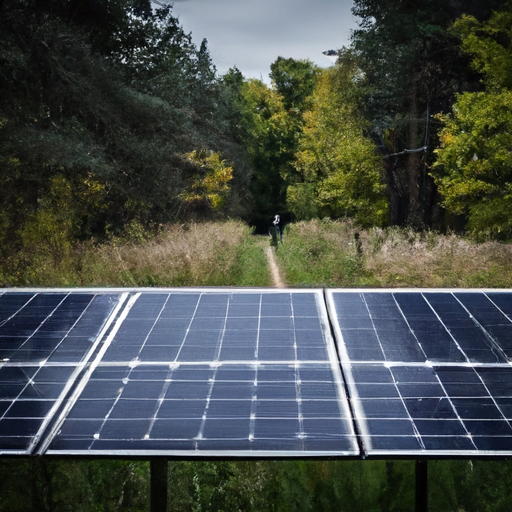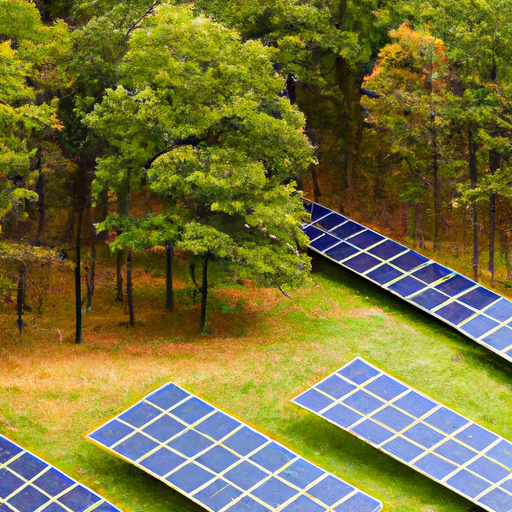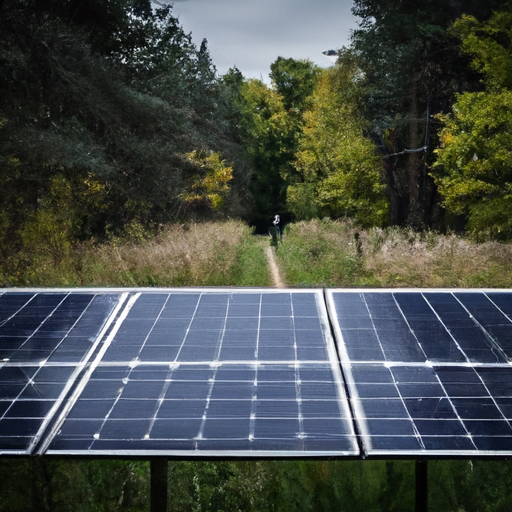So, have you ever wondered how people can live off the grid in the middle of the woods and still have access to power? It seems like a pretty impossible feat, right? Well, I’m here to tell you that it’s actually quite possible, and in this article, we’re going to unlock the secrets of off-grid power in the woods.
When it comes to getting power in the woods, there are a few different options you can explore. One of the most popular methods is the use of solar panels. These panels absorb sunlight and convert it into electricity, which can then be used to power your appliances and devices. This is a great option for those who have a lot of open space and plenty of sunlight.
Another option is the use of wind turbines. These turbines harness the power of the wind and convert it into electricity. They can be a bit more complicated to set up, but if you have a windy area, they can be a great source of off-grid power.
Lastly, you can also explore the use of generators or batteries. Generators run on gasoline or propane and can be used to power your appliances when needed. Batteries, on the other hand, can store the electricity generated by your solar panels or wind turbines and provide power when the sun isn’t shining or the wind isn’t blowing.
In this article, we’ll dive deeper into each of these options and explore how you can make off-grid power work for you in the woods. So, if you’re ready to unlock the secrets of off-grid power, then keep reading and get ready to embrace a more sustainable and self-sufficient lifestyle.

Understanding Off Grid Living
What is off grid living?
Off grid living refers to a lifestyle in which individuals or families choose to live independently from public utilities, relying instead on their own self-sustaining systems for power, water, and waste management. This lifestyle is typically chosen by those seeking a sustainable and environmentally friendly way of life, or those who simply want to disconnect from the grid and live in harmony with nature.
Advantages and disadvantages of off grid living
Living off grid offers several advantages. Firstly, it allows individuals to reduce their carbon footprint and minimize their impact on the environment. By generating their own power, individuals can rely on renewable energy sources such as solar, wind, or hydroelectric power, significantly reducing their reliance on fossil fuels.
Furthermore, off grid living provides individuals with a sense of self-sufficiency and independence. By being responsible for their own power, water, and waste management, individuals have a greater control over their resources and can tailor their systems to suit their specific needs.
However, off grid living does come with its challenges. One of the main disadvantages is the initial cost of setting up the necessary infrastructure. Purchasing solar panels, wind turbines, or micro-hydro systems can be expensive, and the installation process may require professional help.
Additionally, off grid living requires individuals to be more mindful of their power and water consumption. With limited resources, individuals must be efficient in their energy use and adopt conservation practices to ensure they do not run out of power or water.
Exploring Power Sources in the Woods
When it comes to generating power in the woods, there are three main sources to consider: solar power, wind power, and hydroelectric power.
Solar power
Solar power is one of the most popular and accessible off grid power sources. By harnessing the energy of the sun, solar panels convert sunlight into electricity. This renewable energy source is reliable, low maintenance, and can be installed on rooftops or standalone systems.
Wind power
Wind power utilizes the energy of the wind to generate electricity. Wind turbines, whether small-scale or large-scale, capture the kinetic energy of the wind and convert it into electrical power. This source of power is highly effective in areas with consistent wind patterns.
Hydroelectric power
Hydroelectric power, on the other hand, relies on running water to generate electricity. By utilizing the force of flowing or falling water, micro-hydro systems can produce a significant amount of power. This power source is ideal for areas with access to rivers or streams.
Setting up a Solar Power System
When it comes to setting up a solar power system in the woods, there are a few key considerations to keep in mind.
Choosing the right solar panels
To maximize the efficiency of your solar power system, it is important to choose the right solar panels. Consider factors such as the wattage, efficiency rating, and durability of the panels. Additionally, determining the optimal size of the system based on your power consumption needs will help ensure you have enough power to meet your needs.
Installing solar panels in the woods
When installing solar panels in a wooded area, it is important to find a location that receives ample sunlight throughout the day. Clearing away any trees or vegetation that may obstruct the sunlight is crucial. Additionally, consider the angle and orientation of the panels to maximize their exposure to the sun.
Battery storage and inverters
Battery storage is an essential component of a solar power system. It allows for the storage of excess energy generated during the day for use during nighttime or cloudy days. Inverters, on the other hand, convert the direct current (DC) electricity produced by the solar panels into alternating current (AC) electricity that can be used to power appliances and devices.
Maintenance and troubleshooting
Regular maintenance and monitoring of your solar power system is crucial to ensure its optimal performance. This includes cleaning the solar panels to remove any dirt or debris that may hinder their efficiency. Additionally, troubleshooting any issues such as faulty wiring or damaged panels is important to ensure a reliable power supply.

Harnessing the Wind for Power
When considering wind power as a source of off grid power in the woods, there are a few factors to take into account.
Types of wind turbines
There are two main types of wind turbines: horizontal-axis and vertical-axis turbines. Horizontal-axis turbines are more common and are often seen on wind farms. However, vertical-axis turbines are better suited for off grid living due to their ability to capture wind from any direction.
Determining the ideal location for wind turbine installation
Choosing the right location for wind turbine installation is crucial to maximize its effectiveness. Look for areas with consistent and strong wind patterns. Avoid locations surrounded by tall trees or buildings that can obstruct the wind flow.
Connecting the turbine to a power system
To harness the power generated by the wind turbine, it needs to be connected to a power system. This typically involves the installation of a charge controller and an inverter. The charge controller regulates the flow of electricity from the turbine to the battery storage system, while the inverter converts the DC electricity to AC electricity for use in appliances and devices.
Utilizing Hydroelectric Power
If you have access to a river or stream in the woods, harnessing hydroelectric power can be a viable option for off grid living.
Understanding water flow and elevation
To effectively utilize hydroelectric power, it is essential to understand the water flow and elevation of the river or stream. By measuring the flow rate and determining the vertical drop, you can calculate the potential power output of a micro-hydro system.
Building a micro-hydro system
Building a micro-hydro system requires the installation of a turbine, a penstock (pipe), and a generator. The turbine is placed in the flowing water, and the penstock carries the water to the turbine. The turbine is connected to a generator, which produces the electricity.
Optimizing power generation
To optimize power generation from a micro-hydro system, it is important to ensure a consistent flow of water. This may involve building a small dam or diversion channel to regulate the water flow. Additionally, regular maintenance of the system is necessary to keep it functioning efficiently.
Ensuring Reliable Power Supply in the Woods
While off grid living offers independence from public utilities, it is important to have backup power options to ensure a reliable power supply.
Backup power options
Backup power options can include a gasoline or diesel generator, or even a second renewable energy source like solar or wind power. These backup options can provide power during periods of low sunlight, low wind, or during equipment maintenance.
Efficient energy management
Efficient energy management plays a crucial role in off grid living. This involves being mindful of power consumption and adopting energy-saving practices. This can include using energy-efficient appliances, turning off lights and devices when not in use, and optimizing power usage during peak energy production times.
Energy storage solutions
Energy storage solutions, such as batteries or energy banks, are essential for storing excess energy generated during peak production times. This stored energy can be used during periods of low production, ensuring a consistent power supply.
Managing Energy Consumption
To effectively manage energy consumption in the woods, it is important to calculate your power needs, use energy-efficient appliances, and adopt conservation practices.
Calculating power needs
Calculate your power needs by assessing your daily energy consumption. Consider the wattage and usage duration of all appliances and devices in your household. This calculation will help you determine the right size of power system and battery storage required.
Energy-efficient appliances and gadgets
Investing in energy-efficient appliances and gadgets can significantly reduce your energy consumption. Look for appliances with a high energy star rating and choose gadgets that have energy-saving features.
Conservation practices
Adopting conservation practices is essential to ensure efficient energy usage. This can include simple actions such as turning off lights when leaving a room, using natural light during the day, and utilizing passive heating and cooling techniques to minimize the use of energy-intensive heating and cooling systems.
Securing a Sustainable Water Supply
In addition to power, off grid living also requires a reliable and sustainable water supply.
Collecting and treating rainwater
Collecting rainwater can be an effective way to obtain a sustainable water supply. Install a rainwater harvesting system that directs rainwater into storage tanks or reservoirs. Treat the collected rainwater to ensure it is safe for consumption by using filtration systems or adding disinfectants.
Digging a well or accessing natural water sources
If there are natural water sources such as underground aquifers or springs nearby, digging a well or accessing these sources can provide a reliable water supply. Ensure the water is tested for safety and consider installing a pump system to extract the water.
Water storage and filtration systems
To store and manage the water supply, invest in water storage tanks or reservoirs. These containers should be designed to prevent contamination and ensure the cleanliness of the water. Additionally, using water filtration systems can further enhance the quality of the water for consumption.
Addressing Waste Management
Proper waste management is essential for maintaining a clean and sustainable living environment in the woods.
Composting toilets and waste disposal
Off grid living often involves the use of composting toilets, which use natural processes to break down human waste into compost. This eco-friendly option eliminates the need for traditional water-based sewage systems. Additionally, ensure proper waste disposal practices by recycling, reusing, and minimizing waste generation.
Reducing, reusing, and recycling waste
Taking steps to reduce, reuse, and recycle waste is crucial for minimizing the environmental impact of off grid living. This can include using reusable containers, composting organic waste, and repurposing materials whenever possible.
Environmentally-friendly cleaning practices
Adopting environmentally-friendly cleaning practices is important for minimizing the use of harmful chemicals and reducing water consumption. Use natural cleaning solutions such as vinegar or baking soda, and avoid using excessive amounts of water when cleaning.
Conclusion
Unlocking the secrets of off grid power in the woods allows you to embrace a self-sufficient lifestyle while reducing your impact on the environment. By utilizing renewable energy sources such as solar, wind, or hydroelectric power, you can enjoy a reliable power supply and enjoy the beauty of the natural world around you. With proper planning, installation, and maintenance of your off grid power systems, you can create a sustainable and environmentally friendly home in the woods. So go ahead, embrace off grid living and unlock the secrets of power independence!




